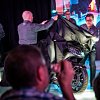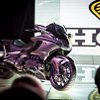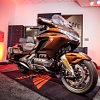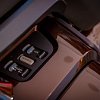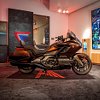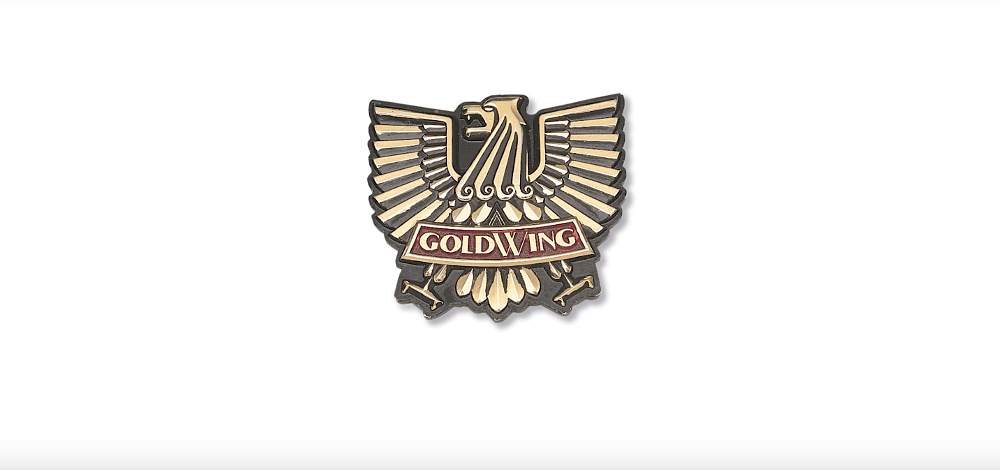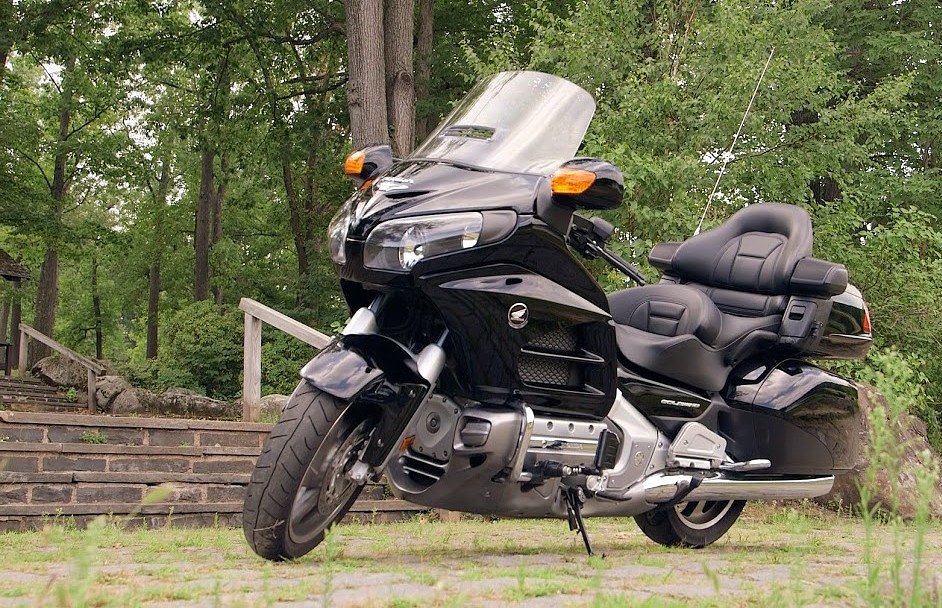After weeks of teaser videos and leaked press photos, Honda has pulled the wraps off a new Gold Wing that's more compact, lighter, more technologically advanced and aimed squarely at attracting a broader range of riders to the model.
The announcement came from the rooftop of MOXI: The Wolf Museum of Exploration and Innovation in Santa Barbara, California. The museum, which puts a focus on hands-on community learning, had been transformed to offer a one-on-one experience with the new bike.

While we were not able to ride the new model (the production versions are still a few weeks away from being finalized), we were given a complete immersion in Gold Wing history, as well as a detailed breakdown of the new machine.
In addition to folks from the traditional motorcycle media, Honda invited along key stakeholders in the Gold Wing brand. Members of Gold Wing riders groups, dealership professionals, and outspoken enthusiasts were included as part of the initial group of folks who were granted access to this first look at the machine. It was great because I was able to gain insight and perspective from people who have been riding, selling, and repairing this bike since before I was even born.
The 2018 Honda Gold Wing
There are now five Gold Wing models ranging in price from $23,500 to $31,500 and built on two platforms: the base Gold Wing and the Gold Wing Tour.

The base package is essentially an updated version of an F6B. It’s a pared-down Wing with no top box and carries over that neo-bagger style. It’s available with a standard transmission for $23,500 or with an all-new seven-speed Dual Clutch Transmission for $24,700.

Bumping to the Tour package gives you that classic Gold Wing style, available in three different setups. The Gold Wing Tour with a manual transmission is available for $26,700, DCT bumps to $27,700, and DCT with an airbag is now $31,500. The airbag option is no longer available with the manual transmission.

In addition to the top box, the Tour provides additional features that I will discuss throughout this article, such as electronically adjustable suspension, damping adjustments actuated via the rider modes, traction control, a larger windscreen, and better accommodations for passengers.
Suspension
In redesigning the Gold Wing, the goal of the engineers was to create a bike that was more compact and performance-oriented than its predecessor while still maintaining its long-haul touring functionality. In order to accomplish this, they started with the front end.
As you can tell by the photos, the new double-wishbone front suspension is a great departure from the traditional telescopic fork design. While it’s easy to draw comparisons to BMW's Duolever front end (Lemmy did a great breakdown of the BMW system in his K 1600 B review), the folks at Honda stress that their design is unique to the new Wing.

For starters, the fork actually connects to the handlebar via a pair of tie rods, very similar to what you would see in the automotive world. The front fork sits in a fork holder, which mounts to the bike via an upper and lower arm. According to Honda, there are multiple benefits to this new design.

Gold Wing owners should no longer have to worry about loose steering head bearings, a problem that plagued many GL1800s. With this new design, the wheel moves vertically up and down under compression, not backwards toward the bike. This means that the front suspension geometry is maintained throughout the stroke, allowing for better handling and feel. Honda claims a 30 percent reduction in shock force transmitted to the handlebar and a 40 percent reduction in inertial mass for the front-end components.

Because the front wheel is no longer traveling towards the engine as the front suspension compresses, engineers were able to move the engine 30 mm forward in the chassis. This allowed the position of the rider to be moved forward, as well. This shift in weight to the front end of the bike further improves front-end feel and handling.
Engine
Engineers worked on refining the Gold Wing's existing six-cyclinder plant in an effort to make it more compact while simultaneously improving performance. Bore has been reduced by one millimeter while stroke has increased by two millimeters. A redesigned crankshaft allowed for a reduction of nine millimeters between cylinders, all of which led to an engine that is 29 millimeters shorter than its predecessor.

The 1,833 cc horizontally opposed six-cylinder engine now features four-valve heads and a single, Unicam design. This is the same system that originated in the CRF450R and was adopted for the Africa Twin. Fuel efficiency has been improved by roughly 20 percent, which allowed engineers to shrink the size of the fuel tank by 1.1 gallons to 5.5 gallons without any significant reduction in the range.

While the physical size of the engine has been reduced, power output has increased. According to the folks at Honda, the new Wing’s peak horsepower was increased by about six to eight ponies, but what’s more impressive is the change to the torque curve. While peak torque stays the same, it gets big boosts in thrust across the middle and top end of the rpm range.
Putting that power to the rear wheel, riders have the option to choose between a six-speed manual transmission or a new, third-generation, seven-speed Dual Clutch Transmission. The DCT operates on the same principles that we’ve seen in the past. You can ride in a fully automatic mode or opt to select your own shift points via the paddle controllers. DCT also now offers a "Walking Mode" which will help you maneuver the Wing both forward and backwards around tight areas. Reverse is a feature available on all the models except the base manual version.

There is no longer a traditional starter on this bike. Instead, Honda has introduced its Integrated Starter Generator system. The ISG system combines the generator and starter into one compact unit, further cutting weight. On the manual version, the ISG still operates the reverse functionality.
Depending on the selected model, the new bike weighs nearly 90 pounds less than its predecessor. More power is great, but less weight means better braking and handling. Combine that with the increases in power and the changes to the suspension and this bike should perform better than ever.
Electronics
The GL1800 was introduced in 2001, the same year the iPod revolutionized the way the world would listen to music and six years before the iPhone changed the way we looked at cellular devices. Over the years, technology continued to advance while the Gold Wing stayed the same. Eventually, Honda began to lose buyers who were interested in current technological trends and the engineers knew they needed to make this bike technologically superior to the competition.

The new Gold Wing model is now the first motorcycle to feature Apple CarPlay, allowing for full integration of your iPhone into the seven-inch, TFT dash. Don’t have an iPhone? You can still link your smart phone to the Wing’s computer via a Bluetooth connection. In addition, you can pair up to two com systems to allow full communication between rider, passenger, and machine.
Throttle control is now electronic and there are four distinct rider modes: Tour, Sport, Econ, and Rain. While these modes control the throttle response on the base version, their functionality is much more sophisticated on the DCT and touring models.

If you opt for a DCT bike, the ride modes alter the shift points when the bike is set to automatic. On the Tour models, their functionality goes even further by controlling the level of engagement of Honda Selectable Torque Control (HSTC). HSTC measures wheel slip and is Honda’s version of traction control on this new machine. It’s standard on the Tour model. The Tour model also gets you electronically adjustable suspension. While riders can select from four different preload settings for the rear shock (there is no preload adjustment for the front fork), it’s the ride modes which control damping at the front and rear of the bike.

There are other electronic updates as well, including Hill Stop Assist, Cruise Control, and Smart Key ignition. The Smart Key system allows for keyless entry and can be shut off to prevent someone from starting the bike if the key is in the vicinity. While the previous version of the Wing featured cruise control, the new version is much more precise, thanks to the new throttle-by-wire system, according to Honda. Hill Stop Assist maintains pressure on the rear brake caliper to prevent the bike from rolling backwards when on an incline. This feature works via the ABS system, something that is now standard across all of the Gold Wing models.
The marketing
Shortly before I flew out to California for this event, my dad sent me an email with a bunch of questions he wanted answered regarding the bike. He reminded me that he was part of Honda’s targeted demographic for this bike and I should approach it through his eyes. His 62-year-old, bifocal-wearing, eyes.
He ended his list of questions with a final observation: “I think Honda’s highest hurdle to overcome is going to be keeping the traditional Gold Wing owners happy while simultaneously convincing younger riders around the age of 40 to step up from their traditional 'sport tourers' to something new and exciting.”

Spurgie Senior, it seems, is thinking like a Honda marketing executive. As I discussed earlier, the overall theme for this bike was to make it more compact and sportier while still carrying on its original touring mission. During the presentation, Lee Edmunds, Honda’s Powersports Marketing Communications Manager, presented a slide which showed the declining sales Honda has seen for the Wing over the past few years. Their goal with this bike is to shift those numbers in the opposite direction. To do this, Honda is targeting three distinct classes of riders.
First and foremost, they want to focus on getting existing Gold Wing customers onto this machine. Second, they want capture returning Gold Wing customers, folks who may have owned a Wing at one point but who now ride something different. And lastly, they want to attract a new, younger audience to the touring market by pulling them off of their current machines and getting them onto a Gold Wing. I think that final segment is still going to be their biggest challenge.
During the presentation, Honda showed us the remaining videos in their “What Lies Beyond” campaign. If you watch the video embedded here, you’ll see a younger couple, not much older than myself, sitting on the couch talking about the friends they haven’t seen in a while. This prompts them to get up and get out on the open road. The Gold Wing becomes the vessel for reconnecting with those folks they haven’t seen in years.
It’s clearly targeted at a more affluent demographic, folks with the money and vacation time to make the trip happen. The couple in this video either doesn’t have kids or they had ‘em super young and they’re now off to college. It’s a powerful, well made video, and hopefully it’ll inspire a few folks to get out and take a few trips on their motorcycles. But is it powerful enough to convince people to drop nearly $27K on a base touring model? Time will tell.
Conclusion
Honda has really given this bike a ground-up redesign. The stack of documents, charts, and stats included in this press kit speaks to the importance of this bike within Honda’s line. More so than any other press launch I have been to, Honda has left us with a lot of information to absorb and this article only scratches the surface.
The main piece of information we lack is what it is like to ride it. According to Honda, we’ll get that chance in early 2018. I look forward to putting my ass in the seat of the new Gold Wing, munching some miles, and seeing exactly what all of these changes mean for Honda’s flagship machine. Until then, there is no shortage of facts to fuel our speculation.































 Riders Preferred Membership
Riders Preferred Membership

